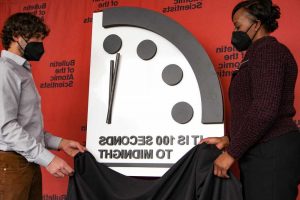Doomsday Clock stays closer than EVER to the apocalypse at just 100 seconds to midnight

THE DOOMSDAY Clock will remain at 100 seconds to midnight for a third year running.
Keeping the same position means the clock's keepers believe the threat an apocalypse is as bad as it has been over the last 24 months.
The Bulletin of the Atomic Scientists hosted a live virtual news conference today to reveal when they think the world will end.
This year, it was deemed the world is "no safer than it was at was last year" and the clock will remain at 100 seconds to midnight.
It was explained: "The decision does not, by any means, suggest that the international security situation has stabilised.
"On the contrary, the Clock remains the closest it has ever been to civilization-ending apocalypse because the world remains stuck in an extremely dangerous moment.
Research professor Sharon Squassoni said: “One hundred seconds to midnight reflects the Board’s judgment that we are stuck in a perilous moment—one that brings neither stability nor security.
"Positive developments in 2021 failed to counteract negative, long-term trends.”
Most read in The Sun
IN COLD BLOOD Moment dad is gunned down in street as little girls play in princess dresses
Boris & Carrie's six-week old baby daughter Romy 'hit quite badly' by Covid
Eighty firefighters tackle massive blaze near homes with 'explosions heard'
Ben Foden calls Rachel Stevens ‘world's sexiest woman’ – after wife's cheat claim
Other speakers included Hank Green, Herb Lin and Professor Raymond T. Pierrehumbert, Scott Sagan.
Two questions are considered when the scientists make their decision – is humanity safer or at greater risk compared to last year, and is humanity safer or at greater risk compared to the last 75 years?
Dr Rachel Bronson said there were "several bright spots and many disturbing trends" taken into consideration for the 2022 clock.
"Because humans created these threats, we can reduce them."
She added: “The Doomsday Clock continues to hover dangerously, reminding us about how much work is needed to be done to ensure a safer and healthier planet. We must continue to push the hands of the Clock away from midnight.”
The clock's position was based on continuing and dangerous threats including nuclear weapons, disruptive technologies and COVID-19.
The Bulletin asked people to help turn back the clock, encouraging people to use social media to share stories about actions that inspire them and strategies to move the world to a safer place.
The Doomsday Clock countdown – which acts as a metaphor for global apocalypse – takes into account the likelihood of emerging threats like war breaking out and the impact of Covid as well as advances in biotechnology and artificial intelligence.
Trackers said they considered factors this year like the prolonged pandemic, proliferation of nuclear weapons in Iran, China and North Korea, state-sponsored disinformation campaigns, and disruptive technologies.
Speculation mounted in 2021 about where the next world war may break out as relationships between Western allies such as the US and UK and their Eastern rivals Russia, Iran, China and North Korea became more fraught than ever.
There's also flashpoints of escalating conflict between North Korea and the US seen during the 1990s and when the rhetoric between Kim-Jong Un and Donald Trump escalated.
When have we been close to midnight before?
The Doomsday Clock launched in 1947 at seven minutes to midnight – but the outlook has got worse over time
- In 1953 the clock lost five minutes because at the time the US and the Soviet Union were testing nuclear weapons
- In 1963 the clock gained those five minutes back because the US and Soviet Union signed the Partial Test Ban Treaty to limit their testing
- By 1968, France and China developed nuclear weapons and took away five minutes from the clock
- In the early 1970s five minutes was given back after three treaties were signed in regards to nuclear weapons
- However, when India tested a nuclear device in 1974 three minutes were taken away
- In 1981, six minutes were lost during the height of nuclear arms race between the US and Soviet union
- In 1991 more treaties were signed and the panel awarded 14 minutes
- By 1998 when India and Pakistan both tested nuclear weapons as well as an increase in military spending by the US a total of eight minutes was taken away
- In 2002, another two minutes were taken away because of 9/11
- In 2007, two were minutes were lost again because North Korea tested nuclear weapons and Iran's nuclear ambitious were murky
- 2017 was the first time the panel took away time that was less than a minute as only 30 seconds was lost
It comes as intelligence chiefs have warned Russia could invade Ukraine by the end of January with a massive assault involving 100,000 troops and thousands of tanks across ten fronts.
Also to consider is the conflict in Iraq between Iranian and American forces “intensified” after Trump’s decision to withdraw from the nuclear deal in 2018.
The countdown was established in 1947 by experts at the bulletin who were working on the Manhattan Project to design and build the first atomic bomb.
It started at seven minutes to midnight but the outlook has got worse in recent years.
The closer the time to midnight, the closer the world is considered to be to catastrophe.
In 2020, the clock lost 20 seconds, pushing it the closest to midnight – and global catastrophe – it has ever been.
Last year, remained at 100 seconds, staying the closest to midnight it has ever been for the second year running amid the devastating effects of the global Covid pandemic.
The Bulletin of the Atomic Scientists spent the last six months debating the decision with the Bulletin’s Board of Sponsors, which includes 13 Nobel Laureates.
Source: Read Full Article






